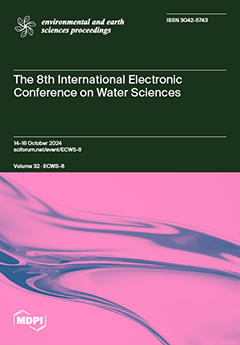This study evaluated the surface area and volume dynamics of the largest and most important natural lakes in the Republic of Moldova: Manta and Beleu. Lakes and surrounding areas represent the main natural ecosystem of the country, are a shelter to thousands of animals and plant species, and are included in the protected areas network. The lakes are situated in the Lower Prut floodplain, with the main water sources being the Prut River through channels, as well as groundwater, surface runoff and precipitation. Regulations of the Prut River flow, climate change, and the increasing frequency of droughts and floods have a certain impact on lake extension and volume dynamics. The main methods used to evaluate surface area variation are the analysis of satellite images (Landsats, from 1975 to 2024) and the application of the NDWI index. As a result, it was identified that the extent of Beleu Lake varied from 0 to 19 km
2, and that of Manta Lake from 5 to 27 km
2. The actual average surface area is 7–11 km
2 for Beleu and 15–19 km
2 for Manta. The last catastrophic drought in 2022 decreased the surface area of Beleu by up to 3.7 km
2 and that of Manta by up to 5 km
2, while the most recent floods in 2020 extended the area of Beleu by up to 12 km
2 and that of Manta by up to 27.3 km
2. The volumes of Beleu vary from 0 to 40 mil.m
3, with an average of 6.5–9 mil.m
3, and of Manta from 4.5 mil.m
3 to 55 mil.m
3, with an average of 15–22 mil.m
3. The shoreline lengths corresponding to the average water surface areas are 14–20 km for Beleu and 35–40 km for Manta.
Full article



